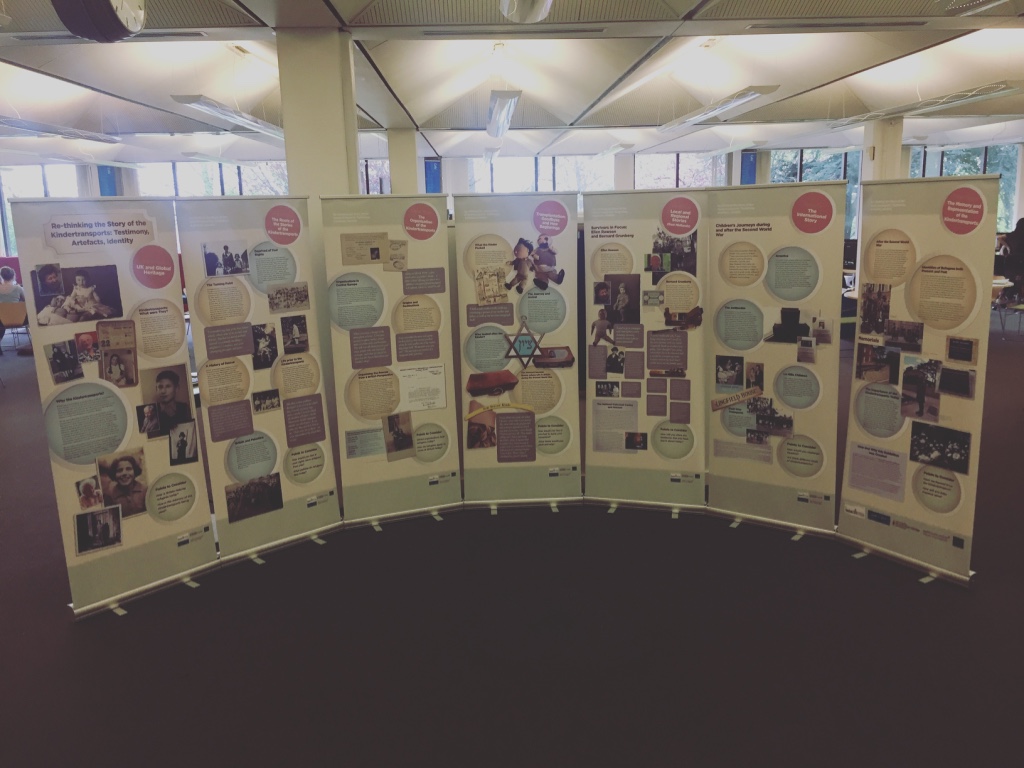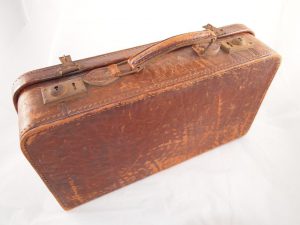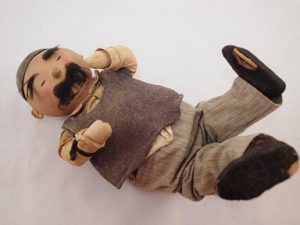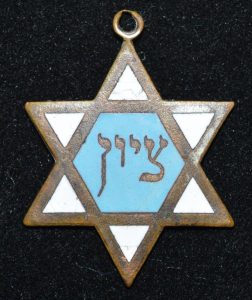
April 12, 2017, by Katherine Beers
‘Rethinking the Story of the Kindertransports: Testimony, Artefacts, Identity’ an exhibition showing the importance of Kindertransports today
A blog about Amy Williams, creator of the exhibition entitled ‘Rethinking the Story of the Kindertransports: Testimony, Artefacts, Identity’ on display at the University of Nottingham’s Hallward Library (until 21 April).
This exhibition was recently created by Amy Williams who is in the second year of her PhD at Nottingham Trent University (NTU). She is funded by the Midlands3Cities AHRC Doctoral Training Partnership. The exhibition explores the complex stories of transplantation, resettlement and adaptation to a new way of life of 10,000 Kindertransportees who fled their homes in Continental Europe to escape Nazi persecution and came to Britain prior to the outbreak of the Second World War. But the exhibition also looks beyond the British national narrative, as it reflects on the international stories of the Kindertransports. Not all the Kinder found new homes in Britain. Some were transported to countries such as Australia and New Zealand. The overall aim of the exhibition is to challenge national assumptions by showing that the story of the Kindertransport is multi-layered.
Kindertransports: What were they?
The rescue and adaptation to a new way of life of 9,354, mainly Jewish children who were sent between 1938 and 1939 by their parents as a last resort to countries such as Britain, Sweden, Holland, and Belgium to escape Nazi persecution. These children are collectively called the Kinder or individually they are known as a “Kindertransportee”.
Most of the Kinder came from the German Reich, which by late 1938 included Austria and the Sudetenland (previously part of Czechoslovakia). A few, however, came from Poland. The children rescued by Nicholas Winton were brought out of Prague just before, but also after the Nazis occupied the rest of the Czech lands in March 1939.
Interest in the Kindertransports
Amy’s undergraduate dissertation focussed on the British memory and representation of the Kindertransports and was written during the year in which we commemorated the 75th anniversary of this historical event. Her Masters then extended this focus to look at how the Kindertransports are represented in works of fiction, and how the works of British authors compare with those who are from other countries. Over the last twenty years, more literature has been produced that has looked towards how Jewish refugees were received in the 1930s and 1940s and how their stories are being remembered today. Her PhD thesis seeks to examine the different national and international memories of the Kindertransport. Kindertransport is understood here as referring not just to the actual rescue of Jewish children from Nazism (1938-1939), but also its effects, i.e. transplantation to a strange environment. There is yet to be a true comparison of how the host nations – Britain, Sweden, Holland, Belgium, the USA, Canada and the Antipodes – received the transportees and integrated them, and of how the memories of the Kindertransportees and the nations’ memories of the Kindertransport developed. A comparison of these various host countries will reveal that memory of the Kindertransport was not uniform, but shaped by national factors such as the role of these countries in the war, their post-war political, economic and social development, social and cultural policies towards refugees, and nationally conditioned memory discourses. However, no memory is entirely nationally bounded. Increasingly, Holocaust memory operates in a transnational, even global network (Levy and Sznaider, 2006); the specific interaction of such global memory with national memory patterns in the case of the Kindertransport will also be examined. For example, the transnational narrative of the Kindertransports is critical and evokes a sense of loss and wondering especially in terms of the identities of the Kinder.
Amy’s supervisors are Bill Niven (NTU), Karl Wilds (UoN), and Nick Hayes (NTU).
How and why was the exhibition created?
This exhibition was created with the help of the National Holocaust Centre and Museum, Journeys to Justice, Midlands3Cities/AHRC, and Nottingham Trent University.
While on placement at the National Holocaust Centre, I was able to look through their archives and collections as well as having the privilege to interview survivors who speak at the Centre. Through one of the Centre’s pieces of work entitled “Strengthening Our Collections”, I was able to discover more about survivors’ objects and documents and the memories that they hold. This, along with the growing need to document survivors’ memories inspired me to create this exhibition, because survivor stories reveal that memory of the Kindertransports is not uniform and many of the host nations have adopted memories of the Kinder into their national narratives. Likewise, stories about injustice are still relevant today as Journeys to Justice highlights through its work, work which aims to inspire and empower people to take action for social justice through learning about human rights’ movements.
A new digital exhibition created by Nottingham Trent University for The National Holocaust Centre and Museum, “Legacies of the Holocaust”, discusses the international, national, and regional aspects of the Kindertransports, and how they have been remembered in Britain. The current exhibition is in part based on “Legacies” and was funded by Midlands3Cities/ AHRC. The Holocaust Centre of New Zealand and Irene Buxton also permitted us to use images from their collections. The digital exhibition “Legacies” will be launched at the National Holocaust Centre on 14 May 2017.
- Objects from the National Holocaust Centre and Museum
What’s next?
Amy is going to be travelling to New Zealand and Australia soon with the aim of interviewing Kinder, visiting the archives, museums, and memorials as well as guest speaking at the Holocaust Centre of New Zealand on 3rd May 2017. Her exhibition is going to be formatted into a booklet and send to school children in New Zealand. The exhibition is also going to be displayed at the Midlands3Cities Research Festival and at the National Holocaust Centre and Museum in Newark, Nottinghamshire, at the end of May 2017.




This is an amazing idea! I would love to see the exhibition!
As a Jew who lives in Israel, I see how every year the Holocaust survivors generation disappeared from the world.
It is very exciting for me to read about amy kindertransports project. Such projects help to preserve the tragedy of the Holocaust.